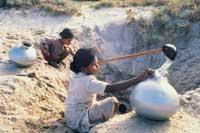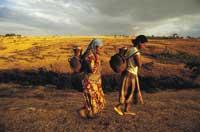More diseases on the hottest planet
2000/11/12 Carton Virto, Eider - Elhuyar Zientzia
models announce that global warming and climate disruptions caused by it will bring us health problems. Some deadly diseases like malaria or dengue spread and become more aggressive.

Higher temperatures can affect health by various means, sometimes directly and sometimes indirectly. The strongest heat strokes belong to the group of direct effects, although sometimes at dusk they bring germ and are not always evident. However, in view of the results of computer models, it seems that from now on it is not too refreshed in the afternoon. It is estimated that by 2020 the number of direct heat victims will double in some places. On the other hand, if the warming is prolonged, it is possible to multiply the pollutant urban smog and disperse the allergenic compounds. Both factors are related to respiratory conditions.
More violent droughts
Global
warming can alter time and threaten human well-being by increasing the frequency and intensity of droughts and floods. XX. Throughout the 20th century it has been observed that as the atmosphere gets warmer, droughts in arid regions have persisted more and heavy rains are more frequent. One cannot be assured that one has provoked the other, but the facts are there. In addition to ending hunger and drowning, these disasters have a second serious consequence that appears in the longer term, because they can be strengthened and spread infectious diseases.
The
final conclusion is very worrying, as it is difficult to re-control the spread infection. In the first attack you can kill fewer people than floods or drought, but once you have rooted in a community, you often face radicalization. This can open up to the environment and cause an epidemic.

Control of infectious diseases is even more difficult in developing countries, where resources for prevention and treatment are scarce. But the first world is not safe from plagues. Just last year, East Nile Virus first appeared in North America and killed 7 people in New York City. A year has passed, but the virus has not yet been controlled. International trade and travel have become commonplace in modern society and the infection that has appeared at one end of the world can quickly become another extreme problem if a favorable environment for the proliferation of pathogens is discovered.
However,
poor countries in the Third World are generally the most frequent victims of these calamities. Droughts and floods associated with climate change, for example, in addition to destroying crops, can make crops more sensitive to disease or subject them to invasive herbs. Consequently, food will be reduced for crops and the ghost of malnutrition can be fed. At the same time, people can temporarily or definitively exiled from their homes, which always means mass elsewhere. It is impossible to avoid the appearance of diseases such as tuberculosis in the succession of massification.
The paradise of mosquitoes
As the planet
warms up, mosquito-contaminated diseases will be, a priori, the most diffuse. For example, malaria, dengue, yellow fever, and some types of encephalitis. This is because mosquitoes are very sensitive to weather. In the face of infectious diseases, intense cold is beneficial for humans as it reduces mosquitoes to certain seasons and regions, limiting the temperature to those above a limit. Frost, for example, destroys eggs, larvae and mosquitoes. Similarly, excess heat is as cold as it is effective against mosquitoes, even though in the hottest air it occurs faster and punctures more often.

Global warming can be accompanied by water-related conditions such as cholera. Droughts can dry up drinking water sources on the one hand and concentrate pollutants that might otherwise be diluted on the other. In addition, due to the shortage of clean water in times of drought, diarrhoea and fever, adequate hydration and hygiene of patients who lose large amounts of fluid becomes unviable, which increases the risk.
Floods
benefit diseases differently: they transport wastewater to drinking water and pathogens that inhabit it and can carry fertilizers. There are algae that reproduce sheltered from dirt, fertilizers and heat. Some release toxic steam for humans and others contaminate us with fish and agitation. Recent studies have found a third way to get sick: algae, as they increase, become support for certain pathogens, such as cholera.
Prevention and responsibility

Measures now taken to address potential
risks will greatly affect the health impact of global warming. One of the defense measures proposed is the implementation of vigilantes to detect you as soon as infectious diseases recover. However, the implementation of this type of real bigilance plans is impossible in most of the world and especially in the poorest, most vulnerable. On the other hand, despite the existence of effective vaccines and treatments for some diseases, the most needy regions do not have resources for their access and distribution. At this point, drug manufacturers do not help much.
Another alternative is the realization of predictions, that is, the way to precalculate both in what climatic conditions and in what risk of spread of the disease. This will enhance prevention. Finally, it is essential to work against warming itself, that is, act responsibly to avoid a change that in addition to health damages the planet.
Malaria and dengue
As temperatures increase, malaria and dengue, both contaminated by mosquitoes, will be the diseases that will spread most. Malaria kills 1,000 people every day, most children and, according to some models, the XXI. By the end of the 20th century there will be 60% of the world in the area of pollution. A black future if we consider that there is no malaria vaccine and that the pathogen is becoming resistant to conventional drugs. Malaria reappears north and south of the tropics: He returns to Korea, southern Europe and the former Soviet Union, to the South African coast.

Dengue is also not left behind. Today there are between 50 and 100 million people in territories close to the tropics, America has expanded greatly in the last ten years and has also appeared in northern Australia. Vaccines and effective treatments are also not available. However, climate change cannot be blamed on everything, even research is opposed to this prediction. A publication in the journal Science, for example, states that mosquito-borne diseases will persist. They have announced that the Malaria region in 2050 will be very similar to the current one and that the number of affected will only vary by 1%, which means approximately 45% of the world population. They say that temperature is only one of the variables that condition the evolution of diseases and that they cannot be considered as complete predictions based on a single variable.
Published in the supplement Natura de Gara

Gai honi buruzko eduki gehiago
Elhuyarrek garatutako teknologia





